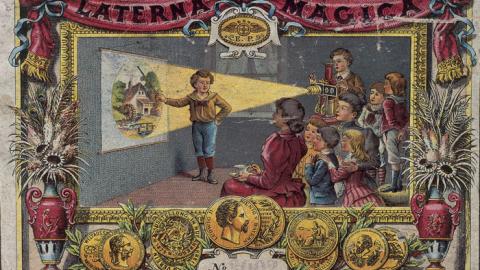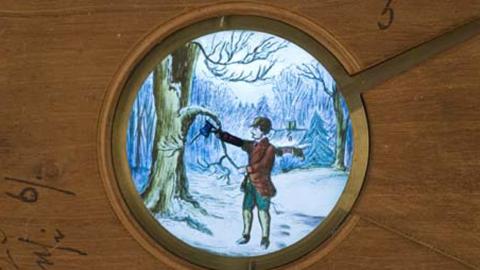

What's that bug?

The Still Image Services team works with some fascinating objects. Lately we’ve been preserving cinema and magic lantern glass slides by scanning them to create digital copies. These glass slides are a form of early media shown to Australian audiences; they were usually seen before a film feature or as pre-cinema entertainment in magic lantern shows. The slides were projected using a magic lantern or cinema projector onto a flat surface like a wall or screen.
There are different types of glass slides in the NFSA collection. The very early ones were framed in mahogany and have mechanical or moving parts built into the frame, which animated the picture on screen. Dissolving view slides were sequential images that faded into each other – a thrilling experience for 19th century audiences. Both of these slide effects were early examples of on-screen special effects. Later, song slides displayed illustrations and song lyrics and were a sort of karaoke for cinema audiences to join in and sing.

This particular magic lantern slide is made with actual butterfly wings. Audiences in the 19th century were fascinated by insects as they had never had the chance to see them enlarged. The butterfly wings are encased between the two glass layers and held within the slide frame. When projected they are part of a dissolving view pair of slides; first this image would have been shown followed by an image of a single butterfly – appearing as if the wings were becoming a whole insect.
While scanning the slide in order to create a duplicate digital image for preservation, we noticed an odd looking splodge on one of the butterfly wings. We magnified the slide section on a microscope to discover a small insect. The insect would have been trapped between the glass slides when it was glued together over 100 years ago. It just goes to show that surprises can be found in all sorts of ways when working with the collection.
Do you know what type of insect this could be? Let us know. Or maybe you can recognise the species of butterfly by the wing patterns. We’d love to hear from you!
UPDATE: We've been contacted by Kate C who believes it to be a booklouse (order Psocoptera) - read more at Museums Victoria.
The National Film and Sound Archive of Australia acknowledges Australia’s Aboriginal and Torres Strait Islander peoples as the Traditional Custodians of the land on which we work and live and gives respect to their Elders both past and present.


